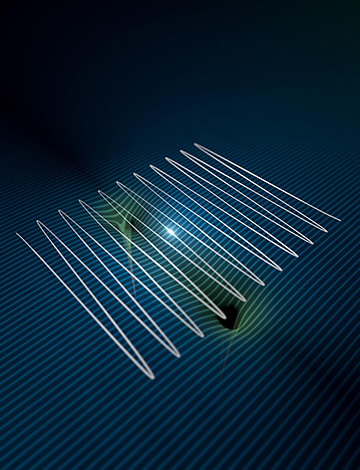
A schematic illustration of the Kramers–Henneberger (KH) potential formed by a mixture of the atomic potential and a strong laser field. [Image: © UNIGE - Xavier Ravinet]
In the familiar picture, a laser pulse kicks a bound electron in a neutral atom to a higher energy level, after which the electron relaxes back, emitting a photon. Jack up the laser field to a high enough power, and the electron can be stripped clean away to photoionize the atom. Since the 1970s, however, theorists have recognized a third possibility: For light fields with strengths well beyond the Coulomb attraction that bind electrons to atoms, the electron can remain in a sort of limbo, oscillating in the powerful laser field, yet still feeling a loose attraction to the atomic core—neither fully bound nor fully free.
A team of European researchers now reveals that these exotic limbo states, known as Kramers–Henneberger (KH) states, can be achieved in clouds of noble gases such as argon and krypton, and can even turn those clouds into a gain medium during laser filamentation in the gas (Nat. Phys., doi: 10.1038/s41567-018-0105-0). The secret? “Dressing” the atoms using specially shaped, high-intensity laser pulses.
Crossing “death valley”
KH states relate to a counterintuitive observation: In the presence of a sufficiently strong laser field, an atom, rather than being ionized, can actually become more stable, owing to distortions in the atom’s wave function. The intensity at which the ionization rate reaches its maximum was nicknamed “death valley” by OSA Fellow and 2007 President Joseph Eberly of the University of Rochester, USA. If death valley can be crossed fast enough, however, it should be possible to drive a substantial fraction of atoms in a gas into a KH state, in which the electrons are “nearly free,” oscillating within the laser field but still loosely bound to the atomic core.
To see how such a state might be realized in practice, the European team—including scientists from the University of Geneva, Switzerland, and the Max Born Institute and the University of Berlin, Germany—began at the computer. The researchers numerically solved the time-dependent Schrödinger equation (TDSE) for an argon atom under the influence of an intense, 800-nm laser field. The TDSE experiments suggested that, at intensities higher than the ionization maximum of 1013 W/cm2, the population of “nearly free,” laser-dressed states would be optimized using a pulse with specific shape: a sharp front of approximately 5 fs (to cross death valley quickly), followed by a flat top (to give the pulse time to maximize the number of laser-dressed atomic states).
The TDSE work also revealed another nugget: At intensities an order of magnitude higher, or 1014 W/cm2, the system of laser-dressed atoms and nearly free electrons should actually experience a population inversion. That raised the possibility that, with the right pulse shaping, the KH effect could turn the gas into a laser gain medium.
The shape’s the thing
Next, the team tested out these predictions, using a chirped-pulse-amplified Ti:sapphire laser combined with a 640-pixel spatial light modulator to produce laser pulses with the appropriate fast rise time and optimum duration. The researchers then passed the tuned, shaped pulses through a pressurized chamber containing argon or krypton gas, and monitored the results with a digital camera and a spectrometer. The results agreed with the theory—while standard-shaped pulses showed a supercontinuum spectrum with no resonant wavelengths, the pulses shaped with a rapid rise time yielded the predicted amplification or gain lines at specific wavelengths, a clear indication of laser-dressed KH states.
OSA Member Jean-Pierre Wolf of the University of Geneva, one of the team leaders in the work, summed up the accomplishment this way in an accompanying press release: “By applying an intensity of 100 trillion watts per square centimeter, we were able to go beyond the death-valley threshold and trap the electron near its parent atom in a cycle of regular oscillations within the electric field of the laser.”
A new gain medium?
Further, the fact that these laser-dressed states can themselves lead to population inversions and laser amplification raises some intriguing prospects in the field of laser filamentation.
It’s been known since the late 2000s that intense lasers propagating in gases, such as air, can experience a self-focusing effect owing to laser-driven refractive-index changes (the nonlinear Kerr effect). The increasingly focused beam leaves a plasma column in its wake, known as a laser filament.
Normally the effect is self-limiting, as the plasma formation leads to local defocusing that counteracts the Kerr-driven self-focusing effect. But the ability to achieve laser gain in such gases by using shaped pulses to create laser-dressed, custom KH states could open previously unavailable prospects for enhancing and controlling such filaments, according to the research team. “This will play a fundamental role,” Wolf suggests, “in the theories and predictions on the propagation of intense lasers in gases, such as air.”
